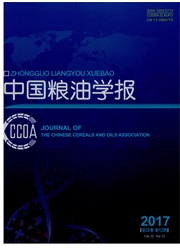

 中文摘要:
中文摘要:
大豆分离蛋白(SPI)经酸性热处理后可自组装形成具有交叉β-折叠结构的纤维聚集体,研究了SPI纤维化对其界面吸附动力学、界面膜扩张流变特征及乳化性质的影响。由于纤维化过程中伴随的蛋白水解,酸性热处理明显改善了SPI在等电点附近的溶解度,但中性pH处溶解度明显下降。SPI纤维化过程中,蛋白表面压增加速度和Ed值明显增强,说明其拥有较高的界面活性,且增强了蛋白分子在界面上的相互作用,易于在界面形成较厚的多层结构。纤维聚集体的形成使蛋白乳液粒径随加热时间延长而不断增加,但其pH稳定性明显增强,明显抑制了其在中性条件下的絮凝,这一改善受加热时间强烈影响。
 英文摘要:
英文摘要:
Soy protein isolate (SPI) could convert to fibrillar aggregates with cross β - sheet structure under self - assembly upon acidity heating treatment at pH 2.0. The influence of SPI fibrillation on the interracial ( adsorption at the oil - water interface and dilatational rheology of interracial layers) and emulsifying properties of SPI was evaluated. The solubility of fibrillar aggregates at near isoelectric point was obviously improved due to polypeptide hy-drolysis during the fibrillation of SPI, while the solubility was significantly decreased at neutral pH. During the fibrillation of SPI, higher interfacial activity was supported by the increase in the increase speed of protein surface pressure and Ed value, and interactions between protein molecules on the interface was enhanced,leading to the formation of the thicker multilayer structure. The formation of fibrillar aggregates maked protein emulsion particle diameter increased with the prolonging of heating time, but its pH stability was enhanced significantly, which significantly suppresses the flocculation under nuetural conditions, while such improvements were influenced by heating time.
 同期刊论文项目
同期刊论文项目
 同项目期刊论文
同项目期刊论文
 期刊信息
期刊信息
